 Free Practice for the Korn Ferry Assessment (KAFLP, KF4D, Talent Q)
Free Practice for the Korn Ferry Assessment (KAFLP, KF4D, Talent Q)
Korn Ferry is a talent management and acquisition company whose signature aptitude tests, The Korn Ferry Assessments, are universally renowned for evaluating leadership and managerial abilities.
Achieving a high score on the Korn Ferry Tests can be an important step toward advancing your career and entering middle and high management.
This page contains a comprehensive practice test that simulated the Korn Ferry Assessment. The following Korn Ferry cognitive and personality tests are covered:
- Korn Ferry Assessment Of Leadership Potential (KFALP)
- Korn Ferry Four Dimensions (KF4D)
- Talent Q Elements
- Talent Q Aspects
The Korn Ferry Assessment — Exercises and Questions
The following sections will offer detailed answers with important key points to consider while taking the Korn Ferry Assessment.
We'll start with the KFALP and KF4D Korn Ferry Assessment test. These two Korn Ferry Tests are known as the Korn Ferry Leadership Assessments.
They are personality tests that aim to collect insights about your work experience and career projection. The evaluation is made up of three separate stages, and we will first focus on the Job Profile Section. This stage includes three activities: selecting, sorting, and ranking cards representing personality traits.
Let's get started:
Job Profile

Question # 1
Step 1 - Selection:
Sort the cards into the three categories according to your current and previous working experience.
Recommended Methodology for Solution
Navigating this stage can be intimidating, especially first encountering the task of sorting into tabs. While this example offers 6 card slots, both the actual test and our PrepPack have 30 different cards and even more slots, applying additional stress to an already stressful assessment. This is why approaching this stage concentrated is crucial. Consider these key strategies:
- Thoroughly review each tab and evaluate its relevance.
- For statements that appear to be similar, differentiate personal, social, and professional skills and whether they are relevant to your role.
- Align your answers with principal values according to the Korn Ferry guide.
- Try your best to give each category an equal number of cards as long as you feel it is correctly put. It is not obligatory.
- Remain focused on sorting into multiple categories instead of just one. This is important because the next stages will require an even distribution of the tabs between the categories.
Question #2
Step 2 - Sorting & Balancing:
Make sure that each of the columns contains an equal amount of cards.
Recommended Methodology for Solution
Although part of the qualities demanded by managers are context and work environment-dependent, others are universal and indispensable for effective management:
1. Influence: Inspiring and rallying your team members to reach a shared goal.
2. Adept Communication: Managers must be experts in communication, whether between themselves, team members, or others. Excellent work and guidance can't be made without the proper communication skills.
3. Taking Responsibility: Managers are accountable for executing tasks, meeting deadlines, and prioritizing properly.
Question #3
Step 3 - Ranking:
Within the different categories, rank the cards from the most important to the least.
Recommended Methodology for Solution
Once the tabs are evenly shared between the categories, the following step is allocating rankings.
As your previous experiences and identity heavily influence ranking, there are no definitive rules.
The main goal of this step is to assess your decision-making, judgment, and ability to closely examine your own personality traits.
At this point, we suggest leaving 2-4 tabs within each category.
The Correct answer is:

Mission Critical:
- Influencing: The ability to sway others is vital for leadership, as it is a major and critical force in driving organizational change and inspiring team members.
- Engagement: Proactive engagement with team members and stakeholders alike is crucial for building strong relationships, fostering teamwork, and maximizing efficiency.
Important Characteristics:
- Adaptability: The business world is ever-changing, and leaders must keep up. Effective response to challenges, embracing change, and encouraging adaptability at the organizational level are key themes in being a good manager.
- Embracing Diversity: Essential for fostering innovation and creating a supportive workspace.
Less Critical Traits:
- Risk-Taking: While having its advantages, risk-taking is not mandatory for management across all organizations and sectors.
- Courage: Similar to risk-taking, while possibly emerging in specific leadership situations, it is not a universal requirement.
More Personality and Leadership Potential Tests on JobTestPrep:
Explore other assessments of personality, integrity, leadership, and culture fit:
16Personalities | Adept-15 | California Psychological Inventory | Caliper | CliftonStrengths | Cubiks PAPI | DDI Leadership Test | Hogan HDS | Hogan HPI | Kolbe | McQuaig Word Survey | MMPI | Myers-Briggs | OPQ32 | Plum Assessment | Police Psychological Exam | Predictive Index | Talogy | TTI Success Insight | WorkKeys Fit | WorkKeys Talent
Job Analysis Questions:
This segment of the Korn Ferry test evaluates numerous metrics regarding your past and current roles, including your personal traits, values, professional background, and behaviors you have encountered throughout your career. For each query, provide a rating on a scale of 1 to 9, reflecting how these qualities are featured in your current occupation.
Question #4
Taking on high-profile responsibilities
Answer
On this scale, the recommended range falls between 7 and 9.
Scale Values:
Assertiveness: The degree to which people enjoy taking charge and directing others. High
scorers tend to be seen as aggressive and decisive. Low scorers are often perceived as tentative, passive, or indecisive and may be more comfortable following the lead of others.
The left option presents a person who is usually not taking responsibility for high-profile issues at work. Korn Ferry is looking for leadership skills and confidence, and these are not demonstrated in this option.
The right option emphasizes the value of assertiveness and responsibility which are central to their values.
Question #5
Obtaining support from others through negotiation
Answer
On this scale, the recommended range is 5-8.
Scale Values:
- Confidence: The degree to which people are convinced that they control the course of events in their lives. High scorers believe that many events and outcomes are within their control and are confident that their future is in their hands. Low scorers believe that fate, luck, or external forces are more important in determining their future.
- Influence: The degree to which people enjoy motivating and persuading others. High scorers tend to be seen as cogent, interpersonally adept, and persuasive. Low scorers are often perceived as interpersonally less confident and less able to inspire or sway others.
On this scale, we recommend rating a high score but not the highest. The right option would represent an influential and confident person who used to work with other people and negotiate to achieve important goals. It is important to remember that Humility is another important value to Korn Ferry, and it's important to stay humble when rating the statements.
As you have seen, the Korn Ferry Assessment is highly intimidating in its complexity. Each of the previously explained stages will demand the proper identification of specific required personality traits, how they come into play regarding work experience and behaviors, and their appreciated magnitude in the eyes of Korn Ferry. While these examples are simple for the sake of understanding, the actual assessment gets considerably more complex and demands thorough preparation. For a comprehensive study guide, including a simulation, feedback and solving strategies, you can explore our Korn Ferry All-Inclusive PrepPack.
Moving on to the next part of the Korn Ferry test, called Individual Exercises. In this section, Korn Ferry examines your character as both an employee and an individual. Within this section are three personality tests:
- What Drives You — personal and professional motivations
- Where Do You Excel — the strengths and qualities that define you
- Who Are You — your identity as an individual, employee and team member
Let's proceed:
Individual Exercises
Question #6
What Drives You?
Within each question, you will be faced with six statements. Rate them from the most important for you to the least important.
Unlike the previous stage, which looked for preferred personality traits within you in the eyes of the recruiters, in this part, we recommend answering authenticly.

Answer
As we are all motivated by different factors, please take the provided rating merely as a suggestion. However, keep in mind that the following rating is based on Korn Ferry's values, specifically those linked to leadership.
Our suggested rating:
1. Taking on challenging tasks: Most like me
This indicates a strong preference for self-improvement and career progression, tackling challenging assignments, welcoming challenges, and continuously honing one's skills and abilities.
2. Staying away from competition: Least like me
This indicates a desire to work in an environment that is less focused on competition and rivalry. It may indicate a preference for a cooperative and supportive work atmosphere that emphasizes collaboration and teamwork.
Question #7
Where Do You Excel?
In each of the questions, seven descriptions will appear which you will have to rate on a scale between the most like me and the least like me.

Answer
Your skills and strengths are unique and subjective, shaped by your past experiences. As in previous stages, keep in mind that the suggested rating is grounded in Korn Ferry's leadership values. Please review the explanation, even if you ranked differently.
Our suggested ranking:
My colleagues need to adjust their approaches to mine: Least like Me
According to this statement, your colleagues may be expected to conform to your preferred way of working or their preferred approaches, rather than accepting different viewpoints or approaches.
It is important to me to view problems from multiple perspectives: Most like Me
This statement indicates that you acknowledge the value of considering diverse viewpoints when tackling problems. It indicates an openness to exploring various perspectives and analyzing situations from different angles to reach well-rounded solutions.
Question #8
Who Are You?
In each of the following questions, 4 tabs will appear when you will have to rank them in the following order:
1. Most like me
2. Somewhat like me
3. Slightly like me
4. Nothing like me
Try to answer honestly and openly, thinking about the qualities that most characterize you and stand out to others and to yourself. It is important to stay consistent and rank similar questions following the same values.
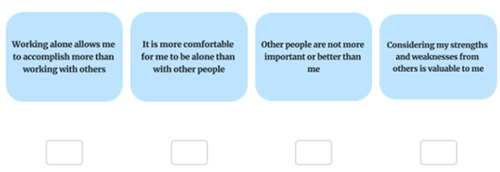
Answer
Since we are all different and unique, consider the rating provided as a recommendation according to Korn Ferry's values and core leadership principles. Please review the explanation, even if you ranked differently.
Our recommended ratings are as follows:
1. Considering my strengths and weaknesses from others is valuable to me: Having self-awareness and being open to feedback and insights is what makes effective leaders. Taking this statement as the highest ranking reflects a willingness to evaluate one's strengths and weaknesses from others' perspectives, aligning with leadership values.
2. Other people are not more important or better than me: Collaborative leadership, teamwork, and acknowledging the value of others are among the values of leadership. Despite the importance of self-confidence, this statement suggests a lack of appreciation for others, which is less aligned with leadership values, placing it in the second position.
3. Working alone allows me to accomplish more than working with others: As a leader, oftentimes, effective delegation, teamwork, and the use of others' strengths are important. However, this statement implies a preference for individual work, which may be less aligned with collaborative leadership values.
4. It is more comfortable for me to be alone than with other people: While some solitude can be beneficial for introspection, effective leaders often thrive in social interactions and building relationships. It suggests a preference for isolation, which is less aligned with leadership values that emphasize effective communication and interpersonal skills, making it the least aligned of the statements provided.
Practice Like The Real Assessment
Unlike typical personality assessments, the KFLAP and KF4D are based on interactive environments and include highly thoughtful questions, both of which add to the challenge. When preparing for these assessments, understanding which qualities to highlight is essential.
Our industry-leading Korn Ferry assessment Prep Course delicately replicates the authentic test platform and offers questions simulating the real thing. Enhance your performance before the real test and effectively showcase your genuine abilities. Take a sneak peek at our interactive course to see how it works:
The next stage of the Korn Ferry Assessment includes Ravens Progressive Matrices Questions, which evaluate Logical Inductive Reasoning. While not directly related to personality assessment, these are integral parts of both the KFALP and KF4D tests, so make sure to invest the time and prepare. These questions include a patterned background, and your objective is to identify the missing cutout among several optional answers. Let's have a look at a couple of those:
Korn Ferry Assessment (KFALP/KF4D) – Ravens
Question #9


Answer
The correct answer is:

The third image in the first two rows is the result of adding a diagonal line pattern to the top half of the first image in the first two rows. Thus, the third image of the bottom row must be the result of adding a diagonal line pattern to the top half of the first image in the bottom row.
Question #10

Answer
The correct answer is:

The missing piece should have black vertical lines that bend outwards and white horizontal lines that bend inwards.
Solving the Raven questions demands more than quick fixes or shortcuts; your only choice for rapidly and correctly solve these is with dedicated practice. Comprehensive study guide and practice tests of different difficulties can be accessed in our All-Inclusive Korn Ferry PrepPack.
Well done! You've successfully completed the Free Korn Ferry Test. However, it's worth noting that personality and inductive preparation make up a significant portion of the Korn Ferry exam, possibly even half. Moving forward, we'll shift our focus to the Korn Ferry Talent-Q Elements and Aspects questions, which constitute the primary cognitive component of the exam. We'll start with the Numerical questions, delving into both Elements and Aspects questions, exploring their distinctions, and discussing the essential skills needed for success in this test.
Now, let's commence the Talent-Q Free Test.
Korn Ferry Talent-Q Elements and Aspects - Numerical
Elements Numerical:
The Elements Numerical test consists of 12 questions, which you have to answer based on information presented in tables. While in the actual test and prep pack, each question consists of one or two tables and 15+ answers; here, you will have a single data table to work with and 5 possible answers.
Table: London — Sydney departure time
| To Heathrow | To Gatwick | From Heathrow | From Gatwick |
| 4:45 | 4:00 | 6:00 | 10:00 |
| 9:15 | 9:30 | 12:00 | 12:30 |
| Every 4.5 hours | Every 5.5 hours | 18:00 | Every 2.5 hours |
| Until | Until | 24:00 | Until |
| 22:45 | 20:30 | 22:30 |
Both Heathrow and Gatwick are British airports.
chedule in GMT. Sydney is GMT+10
Flight time 26 hours
Question # 1
What is the first available flight to Sydney from London after 5:00 pm?
A. 17:30
B. 19:15
C. 20:00
D. 20:45
E. 22:00
The correct answer is 17:30.
Flights to Sydney leave from Heathrow at 06:00, 12:00, 18:00, and 24:00. Therefore, the earliest flight after 5pm (17:00) from Heathrow is at 18:00.
Flights to Sydney from Gatwick leave at 10:00, 12:30, and at intervals of 2.30 hours until 22:30. Therefore, the additional flights are at 15:00, 17:30, and 20:00, so the first flight after 17:00 from Gatwick is at 17:30.
The first available flight after 17:00 from London is the 17:30 (5:30 pm) flight from Gatwick.
Question # 2
What time will it be in Sydney, Australia when the first morning flight out of London arrives?
A. 14:00 +1 day
B. 15:00 +1 day
C. 16:00 +1 day
D. 17:00 +1 day
E. 18:00 +1 day
The first flight to leave London (i.e. from Heathrow/Gatwick) in the morning is the 06:00 from Heathrow. The flight duration is 26 hours, which means the flight arrives at 08:00 GMT the following day. Since Sydney time is GMT + 10, local time will be 18:00 of the next day.
Aspects Numerical
Aspects Numerical also includes 12 questions, and tables from which you will have to gather information when answering each questions. Unlike Elements Numerical, these questions only have 6 optional answers.
Question #3
If a senior citizen were to buy a daily bus pass, how many bus rides would he need to take that day in order for it to be worth while?
A. 1 bus ride
B. 2 bus rides
C. 3 bus rides
D. 4 bus rides
E. 5 bus rides
F. 6 bus rides
The cost of a daily buss pass is $6.00.
The cost of one bus ride is $2.80, but keep in mind that senior citizens are entitled to 50% off the cost of a single bus ride.
Therefore the cost of a single senior bus ride is: 2.80 * 0.5= $1.40.
Now all that is left to ask is: 'how many single bus rides can be bought with $6.00'?
The answer is 4 (6.00/1.40).
However, for the daily bus pass to be worthwhile for a senior citizen, he must go on at least 5 single bus rides.
Numerical questions in the Talent-Q test frequently feature graphs and tables, demanding quick analysis and arithmetic operations. As these questions are high on time constraints, you may be tempted to try and intuitively solve the question and save time, leading to incorrect answers. Below are our top tips for handling Numerical questions in both Elements and Aspects Talent-Q test:
1. Familiarize yourself with the data first: Carefully go through the entire table, understand the headings conveying the meaning of each cell, and do your best to comprehend the data before trying to answer the question.
2. Avoid relying on the answer choices: With up to 30 optional answers, you may be tempted to try to reverse engineer the answers. Refrain from this approach to prevent wasting precious time.
In both numerical sections, each question must be solved within a strict time limit of 90 seconds. This is why thorough preparation, including reading study guides, practicing a large number of format-mimicking questions, and considering the given tips, is recommended. Access study guides and numerous Talent-Q-specific numerical practice questions in our comprehensive Korn Ferry PrepPack.
Next are the Verbal sections, sharing similarities with the Numerical ones. These involve the presentation of a concise text, in the same method as with the tables in the numericals, followed by questions related to the information within the text. These Verbal questions demand multiple distinct skills, such as reasoning, vocabulary, and grammar.
Let's delve further into the Verbal questions.
Korn Ferry Talent-Q Elements and Aspects - Verbal
The Elements Verbal test consists of 15 questions based on passages of text. While they have overall no time limit, there is a time limit for each question: 75 seconds for the first question on each passage of text and 60 seconds for subsequent questions. The average completion time for this test is 12 minutes.
Elements Verbal
EUROPE'S AGING POPULATION
The incentives for having fewer children in rich industrialized countries are the mirror image of the reason to have large families in poor countries. In rich countries children are an expensive luxury while adding nothing to family income. For that reason, among others, the EU has recently come to recognise that it is facing dramatic changes in the age-structure of Europe's population, which have profound economic and social consequences. The ‘dependency ratio’ (the number of people over 65 compared to the number of people aged 20-24) is a good indicator of the fundamental aging population problem. This ratio is now approximately 27 percent; however, by 2050, according to the World Bank, the dependency ratio will double.
To an environmentalist, an aging population might seem a good thing – an indication of an overall stabilizing population. But a small aging population like that of Italy, in a world of huge younger populations like those of China or Brazil, may not be sustainable. First, there's the fear that small, traditional cultures will be overrun. Nevertheless, even if that weren't a factor, there would be economic pressure on a country with a high dependency ratio to alleviate the imbalance by delaying retirement or reducing retirement benefits. All things considered, an aging population of non-workers will necessitate an increased tax burden increased public sector debt, or both.
(Adapted from Europa.eu)
Question #4
Which one of the following is NOT a consequence of the increase in the ‘dependency ratio’?
A. Increased Taxes
B. The extinction of traditional cultures
C. A growth in public debt
D. Stability of population growth rate
E. Delayed retirement
F. Increase in the birth rate
The question asks us to identify 5 consequences of the increase in the ‘dependency ratio’ and 1 that is not. Let us first understand the meaning of ‘dependency ratio’- it is a measure indicating the fundamental aging population problem. Thus, we can rephrase the question so: Which one of the following is NOT a consequence of the aging population problem in Europe? Let us go over the distracters and find the corresponding sections in the text that relate to them:
- ‘An aging population of non-workers will necessitate an increased tax burden’.
- ‘There is a fear that small, traditional cultures will be overrun’.
- ‘An aging population of non-workers will necessitate… increased public sector debt’.
- ‘To an environmentalist, an aging population…[is] an indication of an overall stabilizing population’.
- ‘There would be economic pressure on a country with a high dependency ratio to alleviate the imbalance, by delaying retirement’.
- An increase in the birth rate– Not mentioned as an implication of the aging population in Europe.
Therefore, the statement that is not an implication of the increase in the ‘dependency ratio’ is: statement F.
Question # 5
Which factor does the passage imply is a cause of Europe's aging population?
A. The increased dependency ratio'
B. Environmentalist protests against overpopulation
C. A significant reduction in the labor force
D. Increased taxes
E. Decrease in birth rate
F. Societal norms
The question deals with the causes of Europe’s aging population as presented in the passage. The aging population in defined using the term ‘dependency ratio’, which is defined as ‘the number of people over 65 compared to the number of people aged 20-24’. This means that there is a decline in the younger population, which is associated with a decline in birth rate (statement E). As the text states: ’For that reason (having fewer children), among others, the EU has recently come to recognise that it is facing dramatic changes in the age-structure...’ Note that statement A, although true to the passage, is not a cause of the aging population in Europe. Statement F might be one of the causes, but is not one that is mentioned there.
The correct answer is E.
Aspects Verbal
Question #6

Based on the text, Which one of the following can be concluded from the text?
A. Nature
B. Countryside
C. History
D. Location
The meaning of the word ”setting” in the context of the text is:” the totality of surrounding conditions”. The word ”location” has a similar meaning and thus is the correct answer.
The Talent-Q test verbal questions consist of a brief passage, followed by up to three questions. These questions assess various verbal abilities, including reasoning, grammar, reading comprehension and more.
Follow these essential tips for effectively manage your time when answering these questions:
1. Thoroughly analyze the text and emphasize comprehension. These questions address numeros aspects of the passage.
2. In most instances, you may be able to eliminate at least three answer choices before digging into the more complicated ones.
Practice Under Time Pressure
Time management is of the essence in the Talent-Q test. While some questions can be solved using basic knowledge of mathematics, grammar, and reasoning, achieving real success in this test demands a swift and effective response. With 60-75 seconds for each question, you know that you have no time to waste.
The Talent-Q package includes numerous practice tests with detailed solutions that will assist in building the required time-efficiency and comprehension needed in the real test
Next are the Logical Elements questions. These are highly similar to the Raven questions found in the Korn Ferry Leadership Assessment. However, the Elements Logical questions can be even more strenuous. Let's examine an example to illustrate this.
Korn Ferry Talent-Q Elements - Logical
The Talent-Q Elements Logical consists of 12 questions. There is no overall time limit for the test, but rather a time limit for each question: 75 seconds.
Question #7
Can you identify the missing shape?
Answer
The correct answer is A (top row, leftmost option)
Columns: The matrix is based on the following sequence of symbols: ♥ Ω ≠ ☺ ♣.
Each cell consists of three of these symbols, dictated by the following logic: when moving from one cell to the cell below it, the symbols “move” one step to the right each time. This movement is continuous throughout the matrix’s columns: from the bottom cell in each column to the top cell in the next column.
Thus, to find the missing symbols, we need to “move” the symbols from the cell above it one step to the right, resulting in ‘♥’ and ‘♣’ becoming the right and middle symbols, respectively. Next, we need to work backward and “move” the symbols from the cell below it one step to the left, resulting in ‘☺’ becoming the left symbol. Therefore, the correct answer is #1.
Rows: In a similar way, when moving from one cell to the next in the row (left to right), the symbols “move” two steps to the left each time.
Here are some tips for tackling the Talent-Q Elements Loigcal:
1. Quickly examine the sequence, paying attention to both the rows and columns. Try and identify noticeable patterns.
2. Keep in mind — a single row or column may include several types of patterns.
3. Found a pattern? Great! make sure that it applies to all the figures in a consistent way, both within rows and columns. Next, search for an answer that follows the pattern and adds another logical step.
Next in line are Aspect Checking questions. These questions demand careful attention to detail along with high short-term focus. Let's move forward with an example.
Korn Ferry Talent-Q Aspects Checking
Question #8
Compare 'column 1' with 'column 2' on each row:
- If they are identical, mark the green box (under the √ symbol).
- If they are different, mark the red box (under the X symbol).

Answer
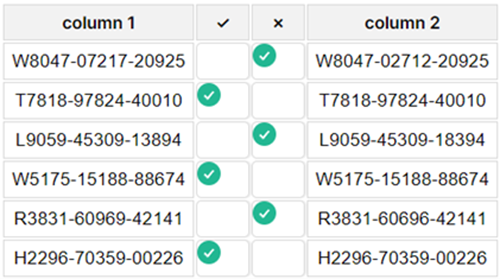
Row 1: W8047-07217-20925 W8047-02712-20925
Row 3: L9059-45309-13894 L9059-45309-18394
Row 5: R3831-60969-42141 R3831-60696-42141
Cehcking questions will evaluate your ability to remain concentrated and observe small details that are frequently challenging to spot. Each question has a time limit of 60 seconds, Thus approaching them methodically is reccomended. While the real test will include complicated checking questions, you can find 3 levels of difficulty within our Talent Q PrepPack, improving your skills at your own pace.
Last but not least, we will move to the Korn Ferry Situational Judgement questions, which assess your values and personality. Let's examine a few illustrative examples.
Korn Ferry Talent-Q – Situational Judgement
Question #9
You have recently hired Jen to join your team. She seems responsible and eager to learn. After a short training period, you feel she is ready to take part in projects and learn from working with more experienced employees. You assign her to Tim, a highly qualified and experienced team member who is currently loaded with work and who you believe could use her help. However, when you talk to Tim about your decision, he objects, saying that tutoring a new employee will only slow down his pace and that he doesn’t want to trust his tasks to someone who is inexperienced.
What would you do in this situation?
Please rate the responses below on a scale of 1 to 5 with 1 being what you are most likely to do and 5 being what you are least likely to do. multiple answers can have the same rating.
| Say that while you understand Tim’s concerns, you want Jen to learn from someone you highly value. You trust that he can adjust to the new situation. |
1 --- 2 --- 3 --- 4 ---5 |
| Ask Tim for his ideas on how to incorporate Jen into his work. | 1 --- 2 --- 3 --- 4 ---5 |
| Tell Tim that despite her lack of experience, Jen is competent and could assist him and reduce his workload. | 1 --- 2 --- 3 --- 4 ---5 |
| Establish with Tim which tasks are simple enough for Jen to begin with, and schedule a meeting to discuss the progress of their work together after a while. |
1 --- 2 --- 3 --- 4 ---5 |
| Respect Tim's decision and assign Jen to another qualified employee. | 1 --- 2 --- 3 --- 4 ---5 |
Answer
Primary competencies: Responsibility for subordinates; Persuasion, motivation, and negotiation skills
Secondary competencies: Social intelligence; Decision-making; Flexibility and adaptability; Maintaining authority
The correct rating is: response #1 → 5, response #2 → 2, response # 3 → 3, response #4 → 1, response #5 → 5
Explanation: In this scenario, an employee objects to your decision.
Response 1: In this response, you acknowledge Tim’s feelings, but you don’t take any action to accommodate these. Whether or not Tim’s objection is justified, his concerns are appropriate and deserve proper consideration. This response shows appreciation for his capability but lacks serious consideration for his concerns. This response lacks responsibility for his situation and is unlikely to motivate him to cooperate. Even though you want him to tutor Jen, it’s better to find ways to motivate him to cooperate so that he will be an effective tutor.
Response 2: This response shows flexibility and adaptability by being open to new ideas. It also demonstrates good decision-making skills by involving Tim in the process and considering his input.
Response 3: This response lacks serious consideration of Tim's concerns as you reject his objections and stand behind your decision. However, you demonstrate persuasion, motivation, and negotiation skills as you try to persuade Tim to work with Jen by highlighting how he could benefit from this decision. You address his concerns seriously and explain how they could be solved using this opportunity. This response demonstrates responsibility for employees as you take a respectful approach to employees’ complaints. However, it lacks flexibility on your behalf as your decision is made.
Response 4: This response demonstrates good decision-making skills as you engage Tim in the decision by taking his input into consideration. You also show responsibility for employees, as you take his concerns seriously.
Response 5: This response shows social intelligence, as you respect your employee's request. However, this response is passive, and it lacks the necessary persuasion, motivation, and negotiation skills expected from a manager, as you immediately give in to your employee's request.
Question #10
You are the head of a department of 18 employees, with three managers working under your supervision. Recently, a new manager has been appointed to your department to replace one that left. In the past month since his appointment, the two veteran managers have complained that the new manager does not seem to delegate tasks, slowing down his team's productivity and consequently resulting in a decrease in departmental efficiency. They ask you to deal with the situation as they feel extremely frustrated.
Please rate the responses below on a scale of 1 to 5 with 1 being what you are most likely to do and 5 being what you are least likely to do. Multiple answers can have the same rating.
| Listen to the managers as they work closely with the new manager on a day-to-day basis, and dismiss him. | 1 --- 2 --- 3 --- 4 ---5 |
| Arrange a meeting with all three managers. Express your confidence in each of them and ask the two more veteran managers to help the new manager get settled by setting up weekly meetings. |
1 --- 2 --- 3 --- 4 ---5 |
| Insist on keeping the new manager in the department despite the other managers' disapproval, as you feel confident in his abilities. |
1 --- 2 --- 3 --- 4 ---5 |
| Arrange a meeting with the new manager. Ask him about any difficulties he has been experiencing in his new position. Offer suggestions for improving productivity and overcoming his difficulties. |
1 --- 2 --- 3 --- 4 ---5 |
| Start holding a weekly meeting with all three managers. In it they will be asked to disclose their individual team progress, achievements and setbacks, and will receive feedback and guidance for improving efficiency when necessary. |
1 --- 2 --- 3 --- 4 ---5 |
Answer
Primary competencies: Responsibility for subordinates; Team building
Secondary competencies: Social intelligence; Problem-solving
The correct rating is: response #1 → 5, response #2 → 3, response #3 → 5, response #4 → 1, Response #5 → 1.
Explanation: You are introduced to a situation in which your employees are frustrated due to the behavior of another colleague. They claim that his shortcomings are influencing the entire department, and they have asked for your intervention. You are obviously facing this problem due to his performance. This item assesses your ability to take responsibility for your employees and resolve conflicts that may arise within your team.
Response 1 shows your ability to take your employees' concerns seriously, thus showing your responsibility towards them. However, this response seems hasty as you have not allowed the manager to explain his behavior. Additionally, you have not been asked to dismiss him, but rather to deal with the situation. It would be best to first discuss the situation with the manager and try to find a solution to the problem before dismissing him.
Response 2 demonstrates your ability to build positive relationships as well as the ability to create opportunities for cooperation. By involving the two other managers in the procedure, you can potentially defuse the negative feelings they have developed towards the new manager and possibly establish a cooperative and functioning team. However, this is only a semi-active response, as on the one hand you gather all three managers and motivate them to work together, but on the other hand, you refrain from intervening by asking the veteran managers to help the new manager while you take a step back. Furthermore, you have not examined the situation to see if there is, in fact, a problem with the new manager's performance. A better response would be to first assess the situation on a one-to-one basis with the new employee.
Response 3 shows a lack of responsibility towards your employees as you do not take their concerns seriously. You also show a lack of team building skills as you do not attempt to resolve the conflict. As a leader and team manager, it is important that you are open to your employees' concerns.
Response 4 demonstrates your ability take responsibility for your employees. By addressing the issue you are taking your employees' concerns seriously. This response enables you to hear the new manager's side of things and to better understand the problem. It also offers a solution by providing him guidance if needed and advising him on how to handle difficulties that he may be facing. This response would probably yield desirable results and solve the conflict between the three managers.
Response 5 demonstrates responsibility for subordinates as you take your employees' concerns and complaints seriously and find a solution for them. This action will enable you to oversee your employee's performance, including that of the new manage. This in turn allows you to intervene when necessary and offer guidance that should increase efficiency, as well as solve the current conflict. This response is a very effective one.
Congratulations! You completed our Free Korn Ferry Free Test! Now that you're familiar with the Korn Ferry Leadership Assessments personality and Talent-Q cognitive tests, it is time to take your practice further. While going through the tips mentioned above will be of help, they will only take you so far. To successfully take the different Korn Ferry and Talent-Q assessments, you will have to challenge yourself with full simulations and practice tests.
Our Korn Ferry All InclusivePrepPack includes comprehensive preparation material, including:
Talent Q Elements & Aspects:
- 10 Numerical Practice Tests
- 5 Logical Practice Tests
- 10 Verbal Practice Tests
- 40+ Extra Cognitive Aptitude Practice Tests & Study Guides
Korn Ferry Leadership Assessments:
- 24+ KFALP & KF4D Tailored Practice Questions
- Dedicated KF4D & KFALP Study Guides
- 1 Full Personality Test
- 30 Single-Trait Practice Drills
- 8 Ravens Metrics Practice Tests


